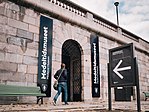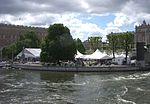Prästgatan
Streets in Stockholm

Prästgatan (Swedish: "The Priest's Street") is a street in Gamla stan, the old town in central Stockholm, Sweden, stretching from a cul-de-sac west of the Royal Palace to the street Österlånggatan in the southern corner of the old town. Prästgatan forms a parallel street to Västerlånggatan, Trångsund, Skomakargatan, and Svartmangatan. It is intercepted by Storkyrkobrinken, Ankargränd, Spektens Gränd, Solgränd, Kåkbrinken, Tyska Brinken, Tyska Stallplan, Mårten Trotzigs Gränd, and Norra Benickebrinken.
Excerpt from the Wikipedia article Prästgatan (License: CC BY-SA 3.0, Authors, Images).Prästgatan
Slottsbacken, Stockholm Gamla stan (Södermalms stadsdelsområde)
Geographical coordinates (GPS) Address Website Nearby Places Show on map
Geographical coordinates (GPS)
| Latitude | Longitude |
|---|---|
| N 59.327027777778 ° | E 18.070277777778 ° |
Address
Stockholms slott
Slottsbacken
111 29 Stockholm, Gamla stan (Södermalms stadsdelsområde)
Sweden
Open on Google Maps











